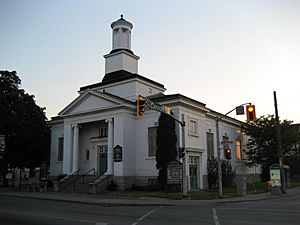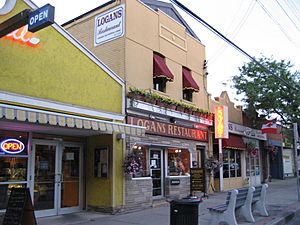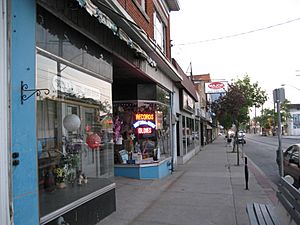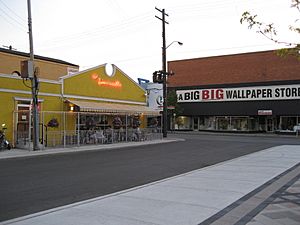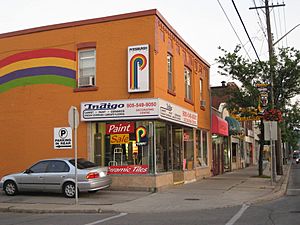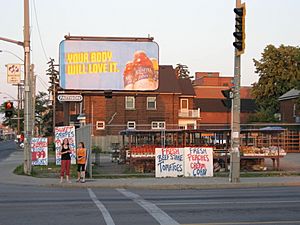Ottawa Street (Hamilton, Ontario) facts for kids
Ottawa Street is a busy road in Hamilton, Ontario, Canada. It starts at Lawrence Road, right at the bottom of the Niagara Escarpment (which is like a big hill or mountain!). This street goes through different neighborhoods, including Delta and Crown Point, and even through the industrial area in the city's North End. It ends near Dofasco, a large steel company.
Long ago, Ottawa Street was one of the ways to get up the mountain. It had some very sharp turns, which made it hard for buses to use. Because of these tricky turns, the Hamilton Street Railway stopped bus service here in 1944. This led the city to plan a new, easier road called the Kenilworth Access, which opened in 1957.
Contents
A Look Back: Ottawa Street's Past
In the past, Hamilton faced some tough times with its economy. But even during these challenges, new businesses started up. One important change was when Richard Wanzer brought sewing machine manufacturing to the city from the U.S.A. This was a big deal because it led to the creation of the "ready-made clothing" industry, which William Eli Sanford helped start in Hamilton.
This new clothing industry grew a lot, especially around Ottawa Street. This area became known as the Textile District. It really boomed during the First and Second World Wars, making lots of clothes and fabrics.
In 1913, a famous company called Procter & Gamble Manufacturing Company, from Ohio, bought land near Ottawa Street. This was their first time opening a plant outside the United States! Construction began in 1914, and by 1915, the Hamilton plant was officially open. It employed 75 workers and made six different products.
Did you know the very first Tim Hortons coffee shop opened in Hamilton in 1964? That original store is still open and operating right here on Ottawa Street!
Centre Mall's Big Makeover
The owners of Centre Mall, located near Ottawa Street, announced exciting plans for a huge new shopping area. They planned to build 23 new buildings, creating a "super centre" with 700,000 square feet of shops! This project was expected to cost around $100 million.
This big makeover was the largest redevelopment project ever in Hamilton's east end. It took about two and a half years to complete, with most of the work done by the end of summer 2008. Some new buildings were even built before the old enclosed mall was torn down. This huge investment in Centre Mall really helped boost Ottawa Street North, which was already a top spot for tourists in the city. The old garment district also changed, becoming a popular area for home decor, with stores selling lighting, antiques, and design items.
Cool Places to See on Ottawa Street
Note: These landmarks are listed from north to south.
- Dofasco, a large steel company
- The former site of the Procter & Gamble Manufacturing Company buildings (they were there from 1913 to 1998)
- Canadian National Railway train tracks
- Centre Mall
- The busy Ottawa Street shopping district
- The original Tim Hortons location, which opened in 1964 and is still serving coffee!
- Bruce Trail, a famous hiking trail
- Mountain Face Park
Main Roads Crossing Ottawa Street
Note: These streets are listed from north to south.
- Industrial Drive
- Burlington Street
- Barton Street
- Cannon Street
- Main Street
- King Street
Roads Running Beside Ottawa Street
Note: These streets are listed from west to east.
- Ferguson Avenue
- Wellington Street
- Victoria Avenue
- Wentworth Street
- Sherman Avenue
- Gage Avenue
- Kenilworth Avenue
- Cochrane Road
- Parkdale Avenue
- Red Hill Valley Parkway
- Nash Road
- Woodward Avenue
Images for kids



